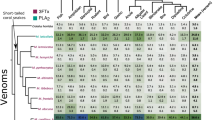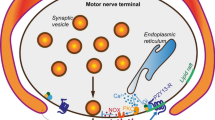Summary
Frog neuromuscular junctions were treated with both concentrated black widow spider venom (BWSV) and elevated extracellular calcium (5–50 mM). This procedure causes a dramatic increase in the frequency of spontaneous miniature endplate potentials (mepps) which persists for only a few minutes. In contrast, BWSV-induced mepp activity, the venom effect (VE), continues for 20 min–1 h at junctions in elevated calcium Ringer solutions treated with doses of dilute venom or at junctions in normal calcium (1.91 mM) Ringer solution treated with concentrated venom. Following the disappearance of the VE in elevated extracellular calcium, only a few normal amplitude mepps and a few giant amplitude mepps are observed. The disappearance of the VE in these preparations is irreversible and occurs whether exposure to elevated extracellular calcium precedes or follows exposure to BWSV.
Electron microscopy indicates that the major structural alterations produced by exposure to concentrated BWSV and 20 mM calcium Ringer solution are the swelling of nerve terminal mitochondria and the clumping of synaptic vesicles, large numbers of which remain in the terminals. Exposure to 20 mM calcium Ringer solution alone produces no ultrastructural modifications in these preparations.
These observations can best be explained if one of the effects of BWSV is to increase the permeability of the nerve terminal membrane to calcium. Only doses of concentrated venom can sufficiently elevate intracellular calcium to a concentration at which synaptic vesicles clump together, thus interrupting the transmitter release process.
Similar content being viewed by others
References
Alnaes, E. andRahamimoff, R. (1975) On the role of mitochondria in transmitter release from motor nerve terminals.Journal of Physiology 248, 285–306.
Baker, P. F. andCrawford, A. C. (1975) A note on the mechanism by which inhibitors of the sodium pump accelerate spontaneous release of transmitter from motor nerve terminals.Journal of Physiology 247, 209–26.
Baker, P. F. andSchlaepfer, W. (1975) Calcium uptake by axoplasm extruded from giant axons ofLoligo.Journal of Physiology 249, 37–38P.
Birks, R., Huxley, H. E. andKatz, B. (1960) The fine structure of the neuromuscular junction of the frog.Journal of Physiology 150, 134–44.
Ceccarelli, B., Hurlbut, W. P. andMauro, A. (1973) Turnover of transmitter and synaptic vesicles at the frog neuromuscular junction.Journal of Cell Biology 57, 499–524.
Ceccarelli, B. andHurlbut, W. P. (1975) The effects of prolonged repetitive stimulation in hemicholinium on the frog neuromuscular junction.Journal of Physiology 247, 163–88.
Clark, A. W., Mauro, A., Longenecker, H. E., Jr. andHurlbut, W. P. (1970) Effects of black widow spider venom on the frog neuromuscular junction: effects on the fine structure.Nature 225, 703–4.
Clark, A. W., Hurlbut, W. P. andMauro, A. (1972) Changes in the fine structure of the neuromuscular junction of the frog caused by black widow spider venom.Journal of Cell Biology 52, 1–14.
del Castillo, J. andKatz, B. (1956) Biophysical aspects of neuro-muscular transmission.Progress in Biophysics 6, 121–70.
DeRrobertis, E., Rodriguez De Lores Arnaiz, G., Salganicoff, L., Pellegrino De Iraldi, A. andZieher, L. M. (1963) Isolation of synaptic vesicles and structural organization of the acetylcholine system within brain nerve endings.Journal of Neurochemistry 10, 225–35.
Dreyer, F. andPeper, K. (1974) A monolayer preparation of innervated skeletal muscle fibres of the m. cutaneous pectoris of the frog.Pflügers Archiv 348, 257–62.
Finkelstein, A., Rubin, L. L. andTzeng, M. (1976) Black widow spider venom: effect of purified toxin on lipid bilayer membranes.Science 193, 1009–11.
Gilbert, E.W. andStewart, C. M. (1935) Effective treatment of arachnidism by calcium salts.American Journal of Medical Sciences 189, 532–6.
Hackenbrock, C. R. andCap Lan, A. I. (1969) Ion-induced ultrastructural transformations in isolated mitochondria.Journal of Cell Biology 42, 221–34.
Heuser, J.E., Katz, B. andMiledi, R. (1971) Structural and functional changes of frog neuromuscular junctions in high calcium solutions.Proceedings of the Royal Society of London, Series B 178, 407–15.
Heuser, J. E. andMiledi, R. (1971) Effect of lanthanum ions on function and structure of frog neuromuscular junctions.Proceedings of the Royal Society of London, Series B 179, 247–60.
Heuser, J. E. andReese, T. S. (1973) Evidence for recycling of synaptic vesicle membrane during transmitter release at the frog neuromuscular junction.Journal of Cell Biology 57, 315–44.
Hubbard, J. I. (1961) The effect of calcium and magnesium on the spontaneous release of transmitter from mammalian motor nerve endings.Journal of Physiology 159, 507–17.
Hunter, D. R., Haworth, R. A. andSouthard, J. H. (1976) Relationship between configuration, function, and permeability in calcium-treated mitochondria.Journal of Biological Chemistry 251, 5069–77.
Hurlbut, W. P., Longenecker, H. E., Jr. andMauro, A. (1971) Effects of calcium and magnesium on the frequency of miniature endplate potentials during prolonged tetanization.Journal of Physiology 219, 17–38.
Hurlbut, W. P. andCeccarelli, B. (1974) Transmitter release and recycling of synaptic vesicle membrane at the neuromuscular junction. InAdvances in Cytophannacology,2, (edited byCeccarelli,B.,Clementi,F. andMeldolesi,J.) pp. 141–54 New York: Raven Press.
Kanaseki, T. andKadota, K. (1969) The ‘vesicle in a basket.’Journal of Cell Biology 42, 202–20.
Karnovsky, M. J. (1967) The ultrastructural basis of capillary permeability studied with peroxidase as a tracer.Journal of Cell Biology 35, 213–36.
Katz, B. andMiledi, R. (1967) The timing of calcium action during neuromuscular transmission.Journal of Physiology 189, 535–44.
Katz, B. andMiledi, R. (1968) The role of calcium in neuromuscular facilitation.Journal of Physiology 195, 481–92.
Katz, B. andMiledi, R. (1970) Membrane noise produced by acetylcholine.Nature 226, 962–3.
Katz, B. andThesleff, S. (1957a) On the factors which determine the amplitude of the ‘miniature endplate potential.’Journal of Physiology 137, 267–78.
Katz, B. andThesleff, S. (1957b) A study of the ‘desensitization’ produced by acetylcholine at the motor endplate.Journal of Physiology 138, 63–80.
Longenecker, H. E., Jr., Hurlbut, W. P., Mauro, A. andClark, A. W. (1970) Effects of black widow spider venom on the frog neuromuscular junction: effects on the endplate potential, miniature endplate potential and nerve terminal spike.Nature 225, 701–3.
Lowe, D.A., Richardson, B. P., Taylor, P. andDonatsch, P. (1976) Increasing intracellular sodium triggers calcium release from bound pools.Nature 260, 337–8.
Manolov, S. (1974) Initial changes in the neuromuscular synapses of denervated rat diaphragm.Brain Research 65, 303–16.
Manthey, A. A. (1966) The effect of calcium on the desensitization of membrane receptors in the neuromuscular junction.Journal of General Physiology 49, 963–75.
Miledi, R. (1973) Transmitter release induced by injection of calcium ions into nerve terminals.Proceedings of the Royal Society of London, Series B 183, 421–5.
Miledi, R. andSlater, C. R. (1970) On the degeneration of rat neuro-muscular junctions after nerve section.Journal of Physiology 207, 507–28.
Nastuk, W.L. andParsons, R. L. (1970) Factors in the inactivation of postjunctional membrane receptors of frog skeletal muscle.Journal of General Physiology 56, 218–49.
Ornberg, R. L. andSmyth, T., Jr. (1976) The physiological mode of action of a presynaptic neurotoxin isolated from black widow spider venom.Neuroscience Abstracts 2, 1009.
Pécot-Dechavassine, M. andCouteaux, R. (1975) Modifications structurales des terminaisons motrices de muscles de grenouille soumis à l'action de la vinblastine.Comptes Rendus des séances de l'Académie des Sciences, Série D 280, 1099–1101.
Rubin, L. L., Gorio, A. andMauro, A. (1977) Effect of concanavalin A on black widow spider venom activity at the neuromuscular junction, (in preparation).
Schlaepfer, W.W. andBunge, R. P. (1973) Effects of calcium ion concentration on the degeneration of amputated axons in tissue culture.Journal of Cell Biology 59, 456–70.
Schlaepfer, W. W. (1974) Calcium-induced degeneration of axoplasm in isolated segments of rat peripheral nerve.Brain Research 69, 203–15.
Smith, J. andClark, A. W. (1975) The interaction of calcium with black widow spider venom at the frog neuromuscular junction.Neuroscience Abstracts 1, 624.
Usherwood, P. N. R. (1973) Release of transmitter from degenerating locust motorneurones.Journal of Experimental Biology 59, 1–16.
Winlow, W. andUsherwood, P. N. R. (1975) Ultrastructural studies of normal and degenerating mouse neuromuscular junctions.Journal of Neurocytology 4, 377–94.
Winlow, W. andUsherwood, P. N. R. (1976) Electrophysiological studies of normal and degenerating mouse neuromuscular junctions.Brain Research 110, 447–61.
Author information
Authors and Affiliations
Rights and permissions
About this article
Cite this article
Smith, J.E., Clark, A.W. & Kuster, T.A. Suppression by elevated calcium of black widow spider venom activity at frog neuromuscular junctions. J Neurocytol 6, 519–539 (1977). https://doi.org/10.1007/BF01205217
Received:
Revised:
Accepted:
Issue Date:
DOI: https://doi.org/10.1007/BF01205217




